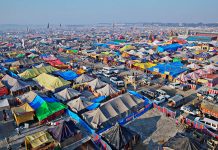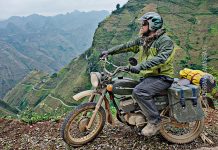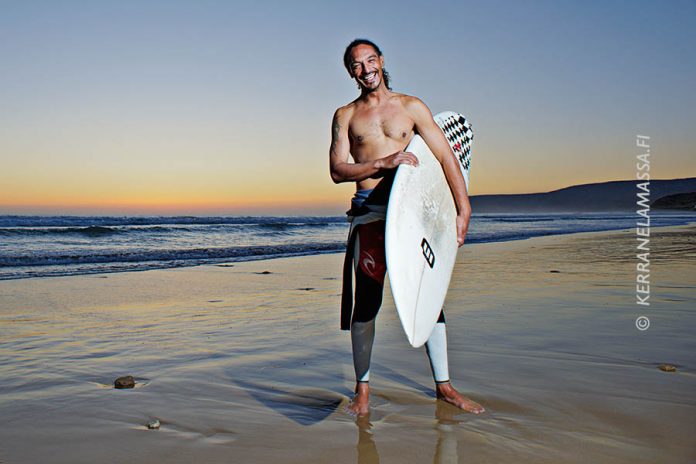
Winds of change are blowing in Morocco. Heritage homes are turned into hotels, and snake charmers protest against commercialism. Even an authentic bathhouse can be found in a surprising place.
Text and photos by Ville Palonen
 The dancing man is dressed up in a pink women’s robe. He shakes his hips like Shakira and flirts with audience, eyes sparkling behind a veil. Nearby, a band accompanies a group of acrobats who build a human pyramid. Snake charmer’s corba dances in a woven basket, and fortune teller whispers secrets into his client’s ear. Ill-advised tourist couple poses for a holiday photo with a chained monkey on their shoulders.
The dancing man is dressed up in a pink women’s robe. He shakes his hips like Shakira and flirts with audience, eyes sparkling behind a veil. Nearby, a band accompanies a group of acrobats who build a human pyramid. Snake charmer’s corba dances in a woven basket, and fortune teller whispers secrets into his client’s ear. Ill-advised tourist couple poses for a holiday photo with a chained monkey on their shoulders.
Djemaa el-Fna is the heart of Medina, Marrakesh’s old town.
That’s how wild Djemaa el-Fna, Morocco’s most famous square, was four years ago. But today the lively square is quiet.
Djemaa el-Fna is the heart of Medina, Marrakesh’s old town. The name of the square means ”assembly of the dead”, because in the olden days the place was used for public executions. Nowadays Djemaa el-Fna is one of the most famous sights in Morocco. In the evenings it bustles with life: acrobats, musicians, dancers. Performers are the reason for the square’s UNESCO world heritage status.
Usually the largest crowd gathers around old men who wear hooded djellaba robes. They are storytellers who borrow their romantic adventures from Arabian Nights tales.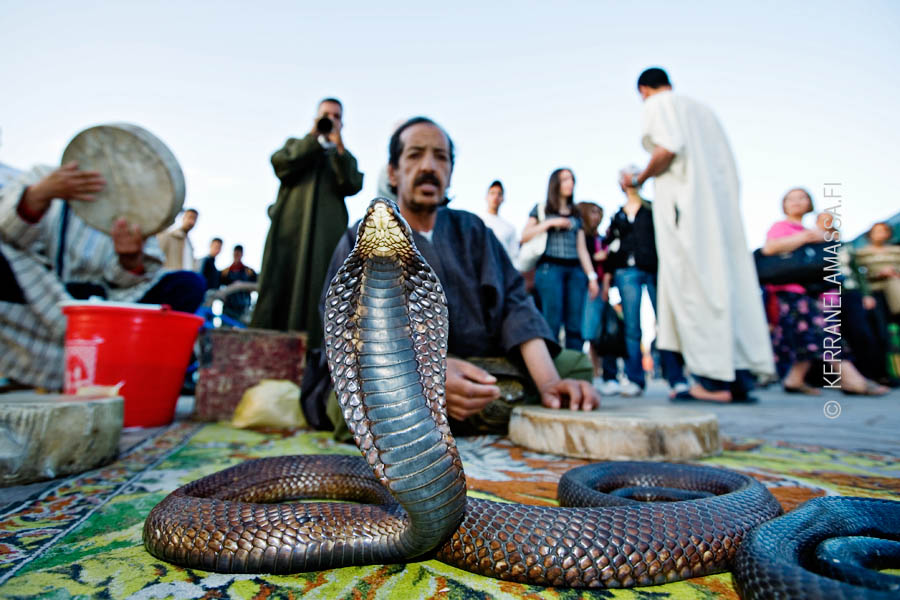
Now the storytellers’ spot in the middle of the square is occupied by wide banners. Slogans are written in Berber and Arabic, but a cardboard sign in English summarises protesters’ concerns: ”Where are the rights of artists of Djemaa el-Fna ?”
Snake charmers’ strike
”I used to earn enough to take care of my family. But lately life has become much harder”, complains Mohamed Bziou, 68. The musician has performed at the square for more than 50 years, but today he doesn’t feel like singing.
”The square has become nothing but a common marketplace. They are hawking henna tattoos and other rubbish for tourists, and there are too many restaurant stands, too. They occupy our performing space and steal all the audience.”
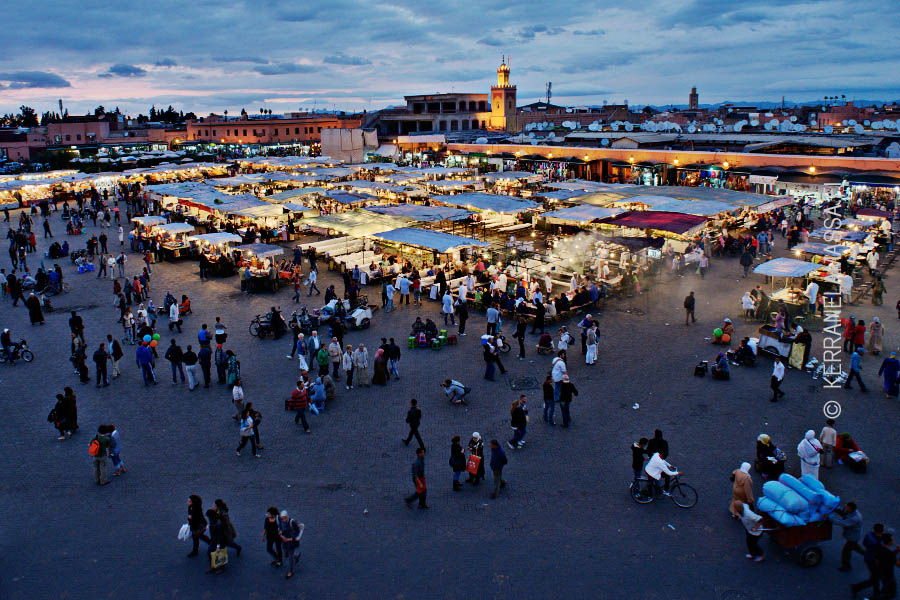
Performers at Djemaa el-Fna make their living by coins and tips from the spectators. The longer you watch a show, the more you pay. Often storytellers pause their tale at a cliffhanger. They hold the ending as a hostage, and release it only after the audience has paid ransom.
It’s a bit ironic that snake charmers and other performers are so infuriated about square’s commercialization. But these men don’t find the situation funny.
It’s ironic that snake charmers are so infuriated about square’s commercialization.
”There’s 450 of us, and we will continue the strike as long as necessary”, blusters Bziou. ”If local authorities don’t come up with a solution, we will march to the capital and ask help directly from our king. Inshallah (God willing)”, the angry man points his finger to the sky.
Marrakesh, adored for it’s traditions, is swept by a wind of change.
Renovated riads
”Majority of riads, traditional Moroccan houses, are owned by foreigners”, reveals Sabah Agrcif. ”In Marrakesh Medina over 200 riads have been converted into hotels.”
The work place of Agrcif, 32, is a marvellous example of tiny boutique hotel in a renovated heritage house. Si Said Riad has a charming courtyard surrounded by columns, floor is covered with colorful tiles, and the fountain is decorated by ornaments.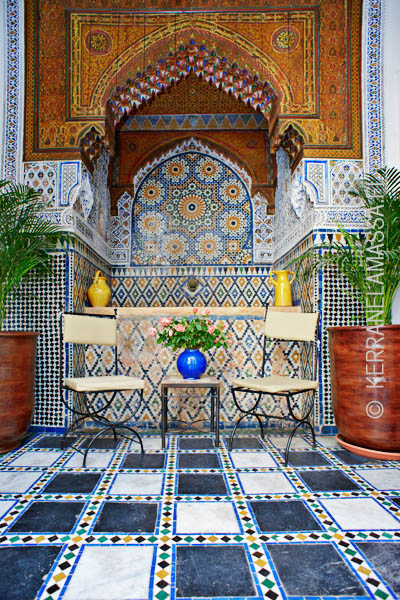
Agrcif explains that renovating a riad can take up to two years. Everything except walls has to be replaced in the centuries old buildings. But renovation is meticulous job: ”Riad is considered a monument, a heritage. You need to focus on details and maintain the traditional touch”, explains Agrcif. ”If you turn everything modern, a riad will be ruined forever.”
”If you turn everything modern, a riad will be ruined forever.”
In the olden days riads were home for the whole extended family. Three or even four generations lived in the same house. The head of a family was the grandfather, who made all important decisions.
But times change. During past 15 years many residents of Medina have sold their homes to foreign investors. ”Younger generations don’t want to live under the same roof with their parents anymore”, explains Agrcif.
It’s also common that families don’t have enough money to renovate an old building. ”They prefer to move into a new flat in a suburb rather than live in a decayed house in Medina.”
The most elaborate riads of Marrakesh are hotels owned by foreigners. Agrcif says that only a few local familes live in a heritage house in the old town. She predicts that after the oldest generation has passed on, their heirs will sell the last traditional riads.
Bustling souqs
Converting a family home into a boutique hotel is a striking example of Morocco’s change. Nevertheless, in the streets of Medina life goes on the same way it has done for centuries.
Cyclist with a live chicken balances on a narrow alley and a donkey cart clatters by. At the street corner a vendor hawks thick bundles of fresh mint from his cart. Old men wear djellaba robes with pointy hoods, women cover their faces with veils.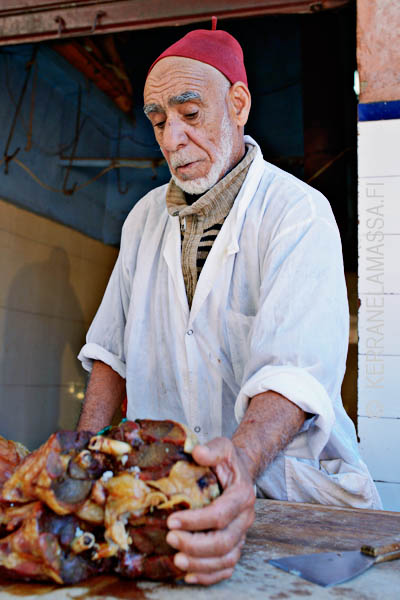
Souq, a labyrinth of shopping streets, spread out north from Djemaa el-Fna. The bazaar area is a handicraft heaven. Shops sell colourful babouche slippers made of leather, felted bags, silver jewellery and silk scarfs, skillfully painted tagine claypots, antique knives, and hand woven Berber carpets. Some of the merchandise is clearly nothing but tourist junk, but Britons and French are too intoxicated by low prices to care.
A whole sheep is cooked inside a two-meter-deep earth oven.
In the north edge of the square a small food corner has bucketfuls of olives and pickled lemons. An aroma coming from the next alley makes my mouth water. Inside a two-meter-deep earth oven, tandir, a full sheep is cooked. Meshoui, a crispy roasted mutton, is spiced with salt and pepper and eaten with khobz flatbread.
The first bite makes corners of my mouth – now dripping with fat – turn into a delighted grin.
One thousand and one nights
After the meaty snack I sit on a terrace of a tourist cafe on the edge of Djemaa el-Fna. Sipping sweet mint tea I watch around. An African lady draws a henna tattoo on hands of an English girl, and talisman vendor advertises his peculiar potions to passers-by. His bright green chameleon tries to escape from a cage, but to no avail.

Suddenly I spot a crowd watching at some kind of a performance. The strike is over!
It’s a comedy show. The shorter of two men is crouching over a worn-out sports bag, talking to it in Arabic. Taller man points his rear with a stick and repeats the lines like an echo. Jokes make the crowd howl with laughter. After a few minutes of fooling around the comedians collect tips from their audience. Bounty is nothing but small coins, but the show must go on.
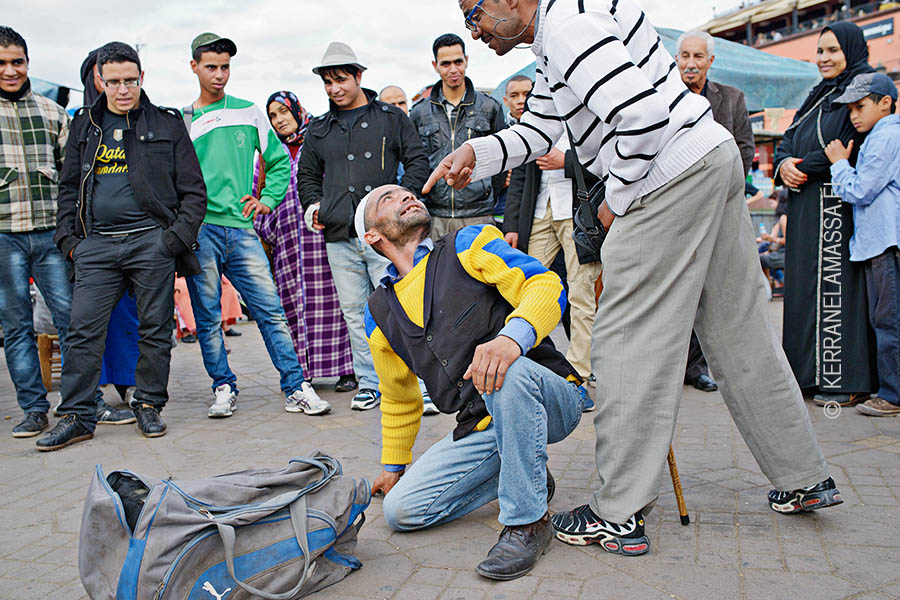
Suddenly two men wearing yellow caution vests storm to the scene. A loud brawl and plenty of pushing and shoving follows. Men with vests turn out to be strike pickets. They are determined to end strikebreakers’ unauthorized performance.
One thousand and one night tales of Djemaa el-Fna seem to be on hold until the strike is over. Fortunately there’s much more to Morocco than just Marrakesh. Along the Atlantic coast a completely different country awaits.
Surf’s up!
A dozen anglers wave their 5-meter-long fishing rods on a rocky peninsula. Waves roll in from the vast ocean, splashing water high in the air when they reach sharp rocks on the shore.
In the middle of waves sway a group of surfers. They sit on their boards astride, staring intensively into the horizon. When a decent wave arrives they start paddling as hard as they can. In a blink of an eye they stand on their boards, riding on the wave towards the shore.
Waves roll in from the vast ocean, splashing water high in the air when they reach sharp rocks on the shore.
One of the surfers flashes a wide smile after each good wave. He is Tarik Wahbi, one of Morocco’s top surfers.
”I have been surfing over 20 years, but still I thank God every time I jump into water. Only a surfer knows that feeling”, Tarik sighs. ”Surfing is therapy, freedom. It’s being connected to the nature.”
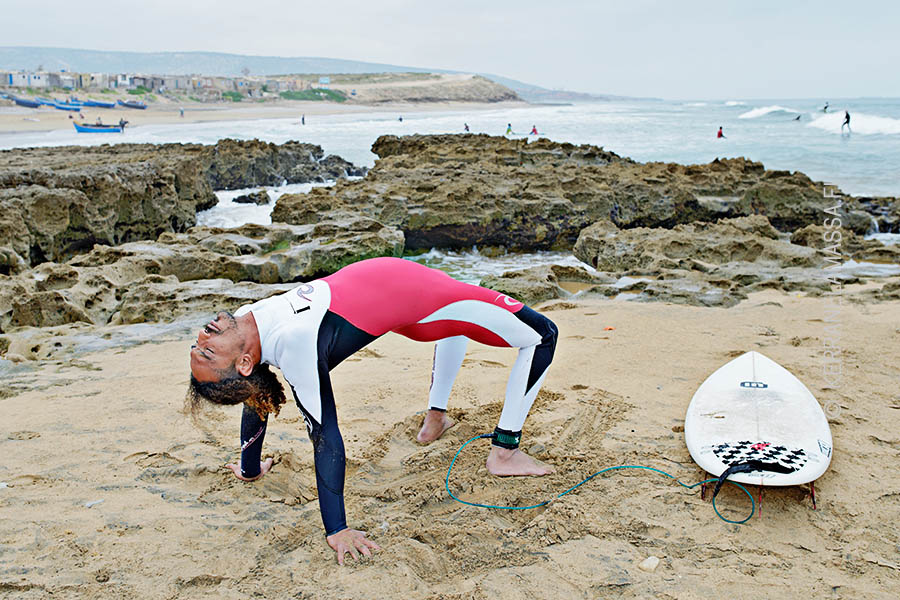
We sit at a tiny surf shop near Taghazout fishing village, one of the best surfing regions of Moroccan coast. Tarik, 35, has changed his wetsuit to dry clothes. Wearing a hoodie and trendy sunglasses he is a genuine poster boy for modern Morocco.
Lifestyle surfer began playing tricks on waves in his teens, in late 80’s. ”I had been bodyboarding for a couple of years when one of my friends asked if I’d like to try his surfboard. I caught the first wave, managed to stand on the board.”
There was no turning back. Tarik found an affordable secondhand board – not a common item those days – and after school was out he spend the entire summer holiday at this very same beach. ”I slept in a tent with safety leash around my ankle, so nobody could steal my board”, he laughs.
After finishing high school Tarik travelled to France and became a surf instructor. In late 90’s he met a Norwegian girl and moved to Trondheim.
”I tried to surf in a fjord in Norway twice. It was pure hell.”
”I lived in Norway until 2007. I tried to surf in a fjord twice, but it was pure hell. Because of icy water you have to wear a wetsuit so thick that you move like a robot.”
Among other jobs Tarik designed skateboard clothes and rapped about social issues in a hiphop crew called Shogunz. ”We even won a national hip-hop competition in 2005.”
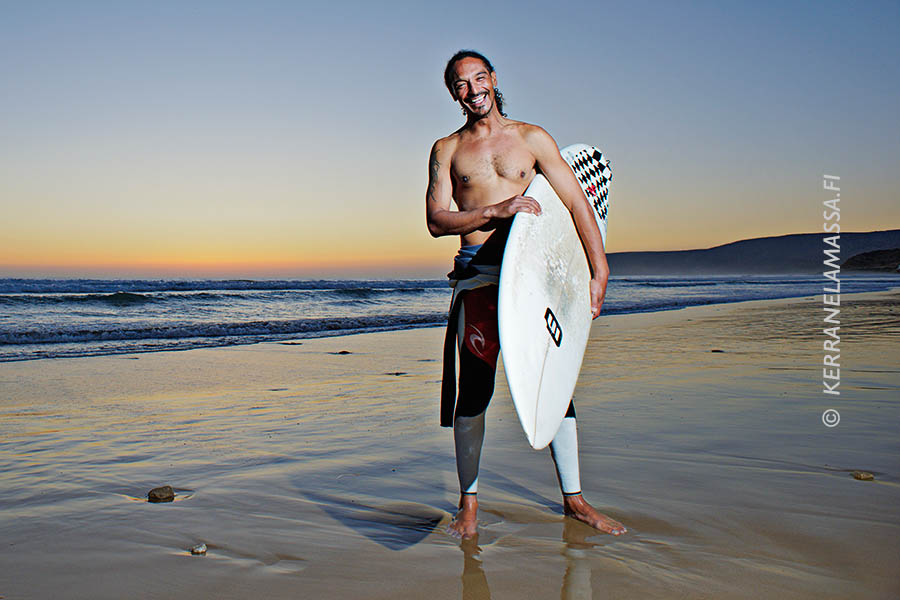
Tarik returned to Morocco in 2007. Now he works as a surf instructor at Paradis Plage, an upmarket resort about 30 kilometres north from Agadir.
Tarik assures that Morocco is a great place to live. ”Other North African countries struggle with unrest and other problems, but not us.”
At least the current king, Mohammed VI, has made more reforms than his despot father. Almost all of the country is connected to the electricity grid, and few years ago the constitution was reformed and Berber was proclaimed an official language alongside Arabic.
”Many people of my age have lived in Europe. After a while they understand what we have in Morocco, and start thinking ’what the hell am I doing abroad?’. Then they return home. If Morocco wasn’t a good country and if our king wasn’t doing a good job, people would not come back.”
A bright smile appears on the surfer’s face: ”It’s possible to live a really good life in Morocco.”
Sweat and sweet tea
In hammam, the difference between good life and painful death is nothing but a line drawn in soap water. I lay on my belly on the steamroom’s floor, hands streched out and face pressed against hot tiles. The brawny man kneeling next to me is twisting my limbs into incredibly painfull positions. I would ask him to be more gentle, but all I can say in Arabic is ”I don’t want to buy anything”.
At the cashier I’ve asked for a gommage, a soap massage that I’ve already experienced in a spa in Marrakesh. There it consisted of exfoliation – scrubbing the skin with black soap made of olives and a coarse glove – and light massage.
Agadir is located on the Atlantic coast and has a population of more than half a million, but there’s nothing much to see except incredibly long beaches.
Gentle tourist treatment is unheard of in Salam Hammam, even though the place is in the centre of Agadir, Morocco’s most popular package holiday destination. Agadir is located on the Atlantic coast and has a population of more than half a million, but there’s nothing much to see except incredibly long beaches. An earthquake destroyed nearly all buildings in 1960, and ”the magical atmosphere of Morocco” was buried in the ruins.
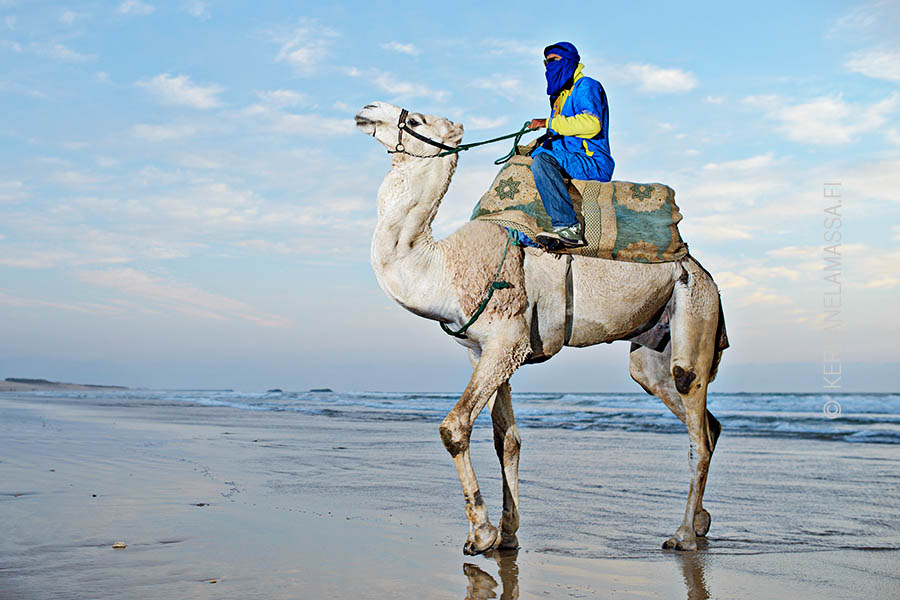
Modern Agadir is boring, but it’s not completely lacking genuine Moroccan experiences.
At least Salam Hammam is more authentic than any tourist spa in Marrakesh, I think in the dressing room after the torturous massage. The place is not a renovated heritage spa, it’s just an ordinary washing place. All the men are local, and nobody speaks English. Signs on the wall forbid nudity (people wear swimsuits in hammam), sitting on buckets made of car tyres, and scrubbing with a glove in dressing room.
When I proceed to pay my soap massage I’m directed to a tea salon opposite to hammam. On the terrace the man who scrubbed me awaits. Said, 30, twists only a few customers per day into a knot, so there’s plenty of time for sipping tea. I wouldn’t mind a cold beer, but my host is convinced that after a hot sauna one must drink something warm.
I wouldn’t mind a cold beer, but my host is convinced that after a hot sauna one must drink something warm.
It’s time for the afternoon’s second authentic experience. Unlike at cafes in Marrakesh’s old town, here ”Moroccan whisky” is served in a traditional way.
Waiter brings a tray with metal tea pot, a few lush mint branches, and a sugar block size of a cigarette pack. First some of the tea is poured into glasses, so pot would have enough room for mint and sugar. Then tea is poured back to the pot, and again to glasses. Pouring is repeated three times, so the drink would be mixed properly.
When I taste the sweet drink I understand that in spite of changes, Morocco is still full of surprises. Traditions can be found anywhere – even at the greenest oasis of package tourism.
PRACTICAL INFORMATION
Accommodation
The best way to enjoy the magical atmosphere of Marrakesh is to stay in a riad hotel. Usually riads have only a few rooms, so booking ahead is essential.
Angsana Riads Collection has 41 rooms in 6 hotels (one of them Si Said Riad), plus their own spa. Double room with breakfast costs 150-200€.
For surfers the place to stay is luxurious but laid-back Paradis Plage. The superb hotel arranges a variety of activities like yoga, surfing, trekking and mountain biking. Double rooms from 150€. 2 days yoga course 56€, 2 days surf course 48€. Longer courses available.
Hammam
A visit to hammam is one of the unforgettable experiences of Morocco. Salam Hammam is located on Rue de Tarfaya, in the centre of Agadir. Entrance costs 1€, soap massage (gommage) 5€. Bring swimsuit and towel. For a steamy experience in Marrakesh, check out Hammam Ziani. Both hammams have separate sections for men and women.
Food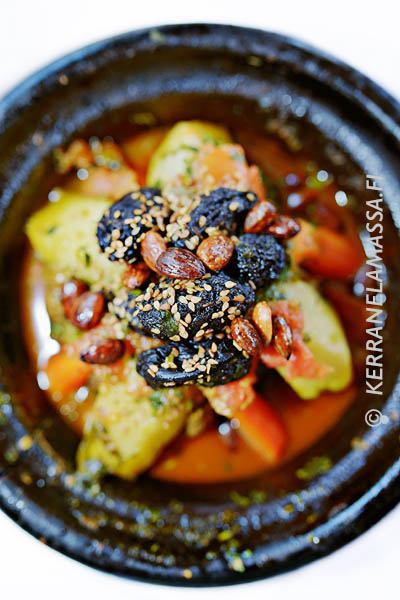
Food in Morocco is very affordable and incredibly tasty. Typical ”must try” dishes include tagine (meat or fish in stew clay pot), pastilla (chicken or pigeon pie topped with powdered sugar and cinnamon), and steamed couscous with vegetables.
More adventurous gourmet tries meshoui (roasted sheep, sometimes even the face and eyes included), tanjia (meat, olives and pickled lemon stew prepared in hammam), and snails (a popular appetizer). Djemaa el-Fna square is famous for it’s night-time restaurants.
Sweet mint tea is a national drink and costs only 0,5-1€ per glass. Djemaa el-Fna has a dozen or more orange juice stands, where a pint of freshly squeezed juice sets you back a mere 0,5€. Alcohol is expensive and usually sold only in hotels.




